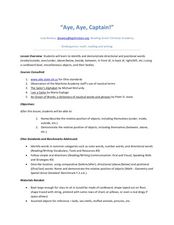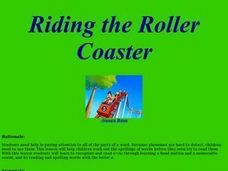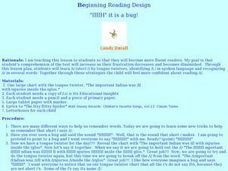Curated OER
Grandpa Ed
Students engage in an emergent literacy lesson that focuses on phonemic awareness. For practice they become more comfortable with a short vowel phoneme, which can often be the most difficult to identify, by learning it in isolation.
Curated OER
The Icky Sticky Igloo
Learners focus on the correspondence i=/i/. They explore the sound and spelling of /i/ and discover vowels are used to spell all words in our vocabulary, so therefore it is important for students to understand the phoneme and grapheme of...
Curated OER
Open Wide
Students recognize the short vowel o in written and spoken language. Through matching activities, students discriminate the short vowel o from the long vowel o. They associate the phoneme with its letter representation and identify the...
Curated OER
Doc Says Open Up
Students recognize the short /o/ sound in spoken words in this lesson. They say a tongue twister with words emphasizing the short /o/ sound. They then listen the the book "Hop on Pop" by Dr. Suess, and identify the words they hear...
Curated OER
Language Arts: Sound Recognition
First graders practice the short i sound by repeating tongue twisters. Later they write the letter i by using the analogy of drawing a straight line from the "fence" down to the "sidewalk" and putting a "basketball" above it. Other...
Curated OER
Icky Fingers
Students are introduced to digraphs so they can match letters to their phonemes. They recognize the short vowel i=/i/ in both spoken and written words by practicing reading and spelling words containing /i/. Elkonin Letter Boxes are...
Curated OER
"Ehhh" I can't hear you!
Students practice writing, sounding out, and identifying words using the short "e" sound. They listen as the teacher reads a tongue twister emphasizing short "e" beginning sounds. The stuents then participate in an activity in which...
Curated OER
Ellen the Elephant
Students build their sight vocabulary. They study the short vowel correspondence e. They practice pronouncing the /e/ phoneme when shown the grapheme e in written words. They read e = /e/ and write words that contain the e...
Curated OER
Aye, Aye Captain
Learners investigate how correspondences appear differently in different words. They also recognize the difference between long and short vowels. Students study how these correspondences are spelled and pronounced differently.
Curated OER
Jack the Fat Cat
Young scholars recognize the short /a/ sound in written and spoken words in this lesson. They say a tongue twister which emphasizes words with the short /a/ sound. They then listen to the story "A Cat Nap" and identify the words in the...
Curated OER
Say Ahh!!
Students identify the short /o/ sound in spoken words, and recognize the letter symbol /o/. They say a tongue twister emphasizing words with the short /o/ sound. They then listen to the story "In the Big Top" and identify the words...
Curated OER
E-E-E-E-Extra E-E-E-E-Effort
Students listen to a tongue twister emphasizing the short e sound. They practice writing the letter e and attaching different words with that sound to it. They listen to a book about a dog that enhances the letter e. They write a...
Curated OER
Let's Help the E Out!
Students explore the short /e/ sound. They practice making the sound, noticing how their mouths move to make the sound. They use letterboxes to spell and write 'e' words. They listen for the /e/ sound in a story and then write their own...
Curated OER
Riding the Roller Coaster
First graders recognize the short vowel a in written and spoken language. Through matching and listening activities, they discriminate the vowel sound /a/ from other phonemes. Students associate the phoneme with its letter representation...
Curated OER
The Creaky Door says /e/
Students explore the short /e/ sound, and identify the short /e/ in writing. Students read fun sentences from the board which emphasize the short /e/. They stretch out the /e/ sound every time they come to it while reading. They then...
Curated OER
"IIIIH" it is a bug!
Students practice the long and short vowel sounds of /i/ in a variety of text with assessing different strategies. They utilize tongue twisters to assist them including "The Itsy Bitsy Spider" and "Liz is Six." Letterboxes are also...
Curated OER
I Feel the Need....The Need for Speed!
Students first learn to decode when learning to read. Decoding each letter and phoneme in a sentence or even a short text takes a considerable amount of time. Students must drill to progress in the pace and level of their reading. In...
Curated OER
Open Your Mouth and Say Ahh!
Students identify and hear distinct sounds in spoken and written language. Then they develop a connection between phonemes and their letter symbols which is a key factor in the success of learning how to read and write. Students also...
Curated OER
Shhh, Be Quiet, We're Trying to Read
Students practice spelling, sounding out, and identifying the "sh" digraph. Students listen as the teacher reads a tongue twister emphasizing words with the "sh" sound. Students listen to the story "Is Joe Home?" and identify the words...
Curated OER
"Open Your Mouth and Say AH!"
Students practice letter and sound recognition of the vowel o=/o/. They study the tongue twister "Tom got a frog from the pond" and the book, "If You Give a Moose a Muffin," by Laura Joffe Numeroff with an accompanying worksheet to master.
Curated OER
CVC Words-Beginning Sound
In this CVC beginning sound worksheet, students say picture words, guess which letter makes the beginning sound, circle the letters that make the middle and final sound and then spell the word beneath each picture.
Curated OER
Bless You
Students practice recognizing the phoneme /a/ in spoken and written words as well as by symbol. They interact with the book, "The Cat Nap," from Educational Insights and the Dr. Seuss book, "ABC's Book." Each student also plays a memory...
Curated OER
AAAAAAAAAAA! Stop Crying!
Students practice recognizing the phoneme /a/ in spoken words. They interact with the book, "A Cat's Nap," and a poster with Abby and Allen on it that are asking animals for apples, and cards with words on them like at, mad, went, bag,...
Curated OER
Icky Sticky Inchworm
Students recognize the short vowel i in written and spoken language. Through matching activities, they discriminate the short vowel /i/ from other vowel sounds. Students associate the phoneme with its letter representation and identify...

























